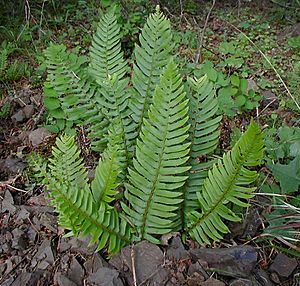Western swordfern facts for kids
Quick facts for kids Western swordfern |
|
|---|---|
 |
|
| Western sword fern growing in the Columbia River Gorge | |
| Scientific classification | |
| Genus: |
Polystichum
|
| Species: |
munitum
|
The western swordfern (also known as Polystichum munitum) is a common green plant found in western North America. It's an evergreen fern, meaning it stays green all year long. You can find it along the Pacific coast, from southeastern Alaska down to southern California. It also grows further inland in places like southeastern British Columbia, northern Idaho, and western Montana. Sometimes, you can even find it in special spots like the Black Hills in South Dakota or Guadalupe Island off Mexico. This fern has also started growing in parts of Great Britain and Ireland.
Contents
What the Western Swordfern Looks Like
The western swordfern has dark green leaves, called fronds. These fronds can grow quite tall, from about 50 centimeters (20 inches) to 180 centimeters (70 inches) high. They grow in a tight group, spreading out from a round base.
Each frond has many smaller leaf parts called pinnae. These pinnae are arranged along the main stem. Each pinna is about 1 to 15 centimeters (0.4 to 6 inches) long. At the bottom of each pinna, there's a small part that points upwards, looking a bit like the handle of a sword. This is how the fern got its name! The edges of the pinnae are jagged and have tiny, stiff tips.
A single frond lives for about 1.5 to 2.5 years. Even after they dry up, the old fronds stay attached to the plant's underground stem, called a rhizome.
If you look closely at the underside of the pinnae, you'll see small, round spots. These are called sori. They are arranged in two rows on each side of the pinna's middle vein. Each sorus is covered by a small, umbrella-like shield called an indusium, which has fringed edges. These sori produce light yellow spores, which are how the fern reproduces.
Where the Western Swordfern Lives and Grows
This fern loves to grow in the shady areas under tall conifer trees in moist forests. It grows best in soil that drains well and is a bit acidic. This soil is usually rich in humus (decaying plant material) and small stones.
The western swordfern is very tough. It can survive short dry periods, but it really thrives when it gets steady moisture and some sunlight. It prefers cool weather.
People also like to grow this fern in their gardens. When grown in a garden, it does well with regular, light plant food. While it's a popular garden plant in western North America, it's much harder to grow successfully in the eastern part of the continent.
In the United Kingdom, the western swordfern (Polystichum munitum) has even won an award called the Royal Horticultural Society's Award of Garden Merit. This award means it's an excellent plant for gardens.
How People Use the Western Swordfern
The Coast Salish people, who live in British Columbia and Washington state, have traditionally used this plant to help with pain. Della Rice Sylvester, an elder and medicine woman from the Cowichan tribe, says that putting the sword fern directly on a painful or swollen area "takes the pain away!"
This traditional use has become well-known among hikers and youth groups in the area. It's a common tip that if you get a rash from a stinging nettle plant, rubbing the spores from the underside of a sword fern on the rash can help.
In the spring, when other foods might be hard to find, Native American and First Nations peoples like the Quileute, Makah, Klallam, Squamish, Sechelt, and Haida would roast, peel, and eat the underground stems (rhizomes) of the swordfern.
The fronds of the fern were also very useful. They were used to line fire pits and racks for drying food. People also used them as soft padding inside mattresses. Today, the plant is also grown for its beautiful green leaves, which florists often use in flower arrangements.
See also
 In Spanish: Helecho de espada occidental para niños
In Spanish: Helecho de espada occidental para niños

